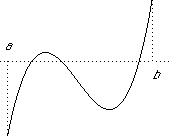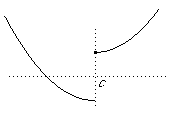Continuity can be defined in several different ways which make rigorous the idea that a continuous function has a graph with no breaks in it or equivalently that "close points" are mapped to "close points".
For example,  is the graph of a continuous function on the interval (a, b)
is the graph of a continuous function on the interval (a, b)
while  is the graph of a function with a discontinuity at c.
is the graph of a function with a discontinuity at c.
To understand this, observe that some points close to c (arbitrarily close to the left) are mapped to points which are not close to f (c).
We will give a definition in terms of convergence of sequences and show later how it can be reformulated in terms of the above description.
Definition
We also have the following.
Definition
Similarly we may define the difference, product and quotient of functions.
For example: to prove that f + g is continuous at p ∈ R
Suppose (xn)→ p. We are told that (f (xn))→ f (p) and (g(xn))→ g(p) and we must prove that (f + g)(xn))→ (f + g)(p).
But the LHS of this expression is f (xn) + g(xn) and the RHS is f (p) + g(p) and so the result follows from the arithmetic properties of sequences.

 f is defined by g
f is defined by g  f (x) = g(f (x)).
f (x) = g(f (x)).We assume that f is continuous at p and that g is continuous at f (p). So suppose that (xi)→ p. Then (f (xi))→ f (p) and then (g(f (xi)))→ g(f (p)) which is what we need.

- Clearly the identity function which x ↦ x is continuous.
Hence, using the above, any polynomial function is continuous and hence any rational function (a ratio of polynomial functions) is continuous at any point where the denominator is non-zero. - We will see later that functions like √, sin, cos, exp, log, ... are continuous. It follows that , for example sin2(x + 5), exp(-x2), √(1 + x4), ... are continuous since they are made by composing continuous functions.
| Previous page (Cauchy sequences) | Contents | Next page (Limits of functions) |